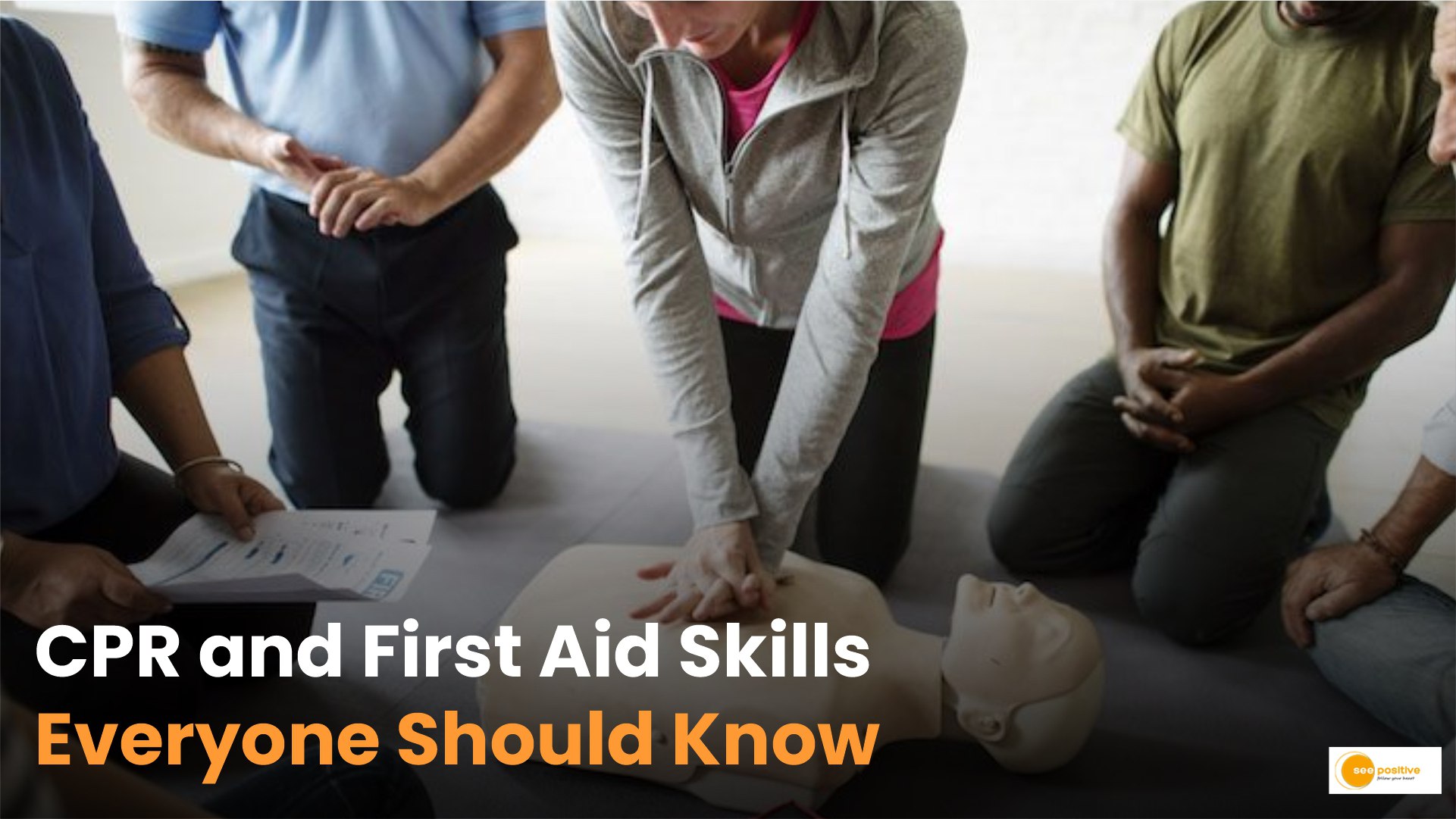First Aid Skills: First aid and CPR skills are invaluable, providing the knowledge needed to potentially save lives in emergencies. Quick, informed action can prevent a minor injury from becoming life-threatening and, in severe cases, can sustain life until professional help arrives. Here’s a guide to some essential first aid skills and CPR techniques everyone should be familiar with.
CPR (Cardiopulmonary Resuscitation)
One of the most critical skills in an emergency, CPR, can help sustain life when someone’s heart or breathing has stopped. It is especially useful in situations like heart attacks, drowning, or electric shocks.
Steps for Performing CPR:
1. Check Responsiveness: Gently shake the person and ask if they’re okay. If there’s no response and they aren’t breathing, prepare for CPR.
2. Call for Help: If someone else is nearby, ask them to call emergency services. If you’re alone, call for help yourself before beginning CPR.
3. Begin Chest Compressions:
– Place the heel of your hand on the center of the chest, with your other hand on top. Interlace your fingers.
– Press hard and fast, compressing the chest about 2 inches deep at a rate of 100-120 compressions per minute (think of the beat of the song “Stayin’ Alive”).
– If you are trained, you can provide rescue breaths at a ratio of 30 compressions to 2 breaths. If not, continue compressions until help arrives.
4. Continue Until Help Arrives: Don’t stop compressions unless you’re too exhausted to continue or a professional takes over.
Treating Choking
Choking can block the airway, making it difficult or impossible for someone to breathe. Acting fast is key to helping them regain airflow.
– Steps to Assist a Choking Adult or Child Over 1 Year:
1. Ask if They Are Choking: If they can’t speak, cough, or breathe, it’s time to act.
2. Perform the Heimlich Maneuver:
– Stand behind the person and wrap your arms around their waist.
– Make a fist and place it above the navel.
– Grasp the fist with your other hand and press into the abdomen with quick, upward thrusts.
3. Continue Until the Object Is Dislodged or Help Arrives: For a conscious child or infant, modifications in the Heimlich maneuver are needed. If you’re not trained in these techniques, calling emergency services is essential.
Managing Severe Bleeding
Uncontrolled bleeding can quickly become life-threatening. Knowing how to stop it is critical.
Steps to Control Severe Bleeding:
1. Apply Pressure: Use a sterile cloth or bandage to apply direct pressure on the wound.
2. Elevate the Wound: If possible, raise the injured area above the heart to slow the blood flow.
3. Use a Tourniquet (if necessary): For severe, uncontrollable bleeding from a limb, apply a tourniquet above the injury to restrict blood flow. This is a last resort when direct pressure isn’t enough.
4. Keep the Person Calm and Still: Reducing movement can help prevent shock
Treating Burns
Burns can range from mild to life-threatening. The key is cooling the burn and protecting the skin.
Steps for Treating Minor Burns:
1. Cool the Burn: Rinse the area under cool (not ice-cold) water for 10-15 minutes.
2. Cover the Burn: Use a sterile, non-stick bandage to protect the burn from infection.
3. Avoid Applying Butter or Ointments: This can trap heat and worsen the burn.
For Severe Burns: Call emergency services and cover the burn with a clean cloth. Avoid touching or removing burned clothing stuck to the skin.
Handling Fractures and Sprains
Broken bones and sprains are common injuries. Proper first aid can stabilize the injury and prevent further damage.
Steps to Treat Fractures and Sprains:
1. Stabilize the Area: Avoid moving the injured part. Use a splint or any rigid item (like a stick) and tie it gently to immobilize the area.
2. Apply Ice: Wrap ice in a cloth and apply it to reduce swelling and pain.
3. Seek Medical Help: Call emergency services for a fracture, as it requires professional care.
Responding to Heart Attacks
Heart attacks are a medical emergency where quick response can mean the difference between life and death.
Steps to Take in Case of Heart Attack Symptoms:
1. Call Emergency Services Immediately.
2. Keep the Person Calm and Seated: Encourage them to rest, as lying down can worsen symptoms.
3. Provide Aspirin (if available): If the person is not allergic and has no contraindications, chewing an aspirin may help slow blood clotting.
Dealing with Hypothermia and Heat Stroke
Exposure to extreme temperatures can cause hypothermia (cold) or heat stroke (hot).
Hypothermia:
1. Move the Person Indoors: Remove wet clothing and wrap them in warm blankets.
2. Offer Warm Beverages: Avoid alcohol and caffeinated drinks.
Heat Stroke:
1. Move to a Cool Area: Get the person out of the heat and offer water.
2. Cool the Body: Use a damp cloth or fan to bring down body temperature.
Final Thoughts
Being prepared with these essential first aid skills and CPR knowledge can save lives in critical moments. Remember, taking a certified first aid and CPR course can help ensure your technique is correct and provide practice with life-saving skills. Even a little knowledge can make all the difference in an emergency.


